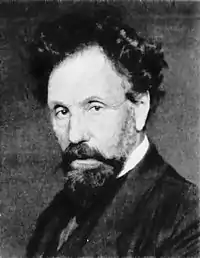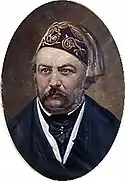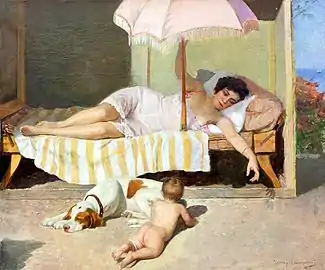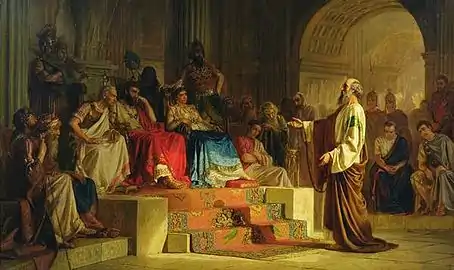Nikolai Bodarevsky
Nikolai Kornilievich Bodarevsky (Russian: Николай Корнилиевич Бодаревский; 6 December 1850, Odessa — 1921, Odessa) was a Ukrainian-born Russian painter and art professor; associated with the Peredvizhniki.
Nikolai Bodarevsky | |
|---|---|
 Nikolai Bodarevsky; from the journal Niva (1913) | |
| Born | November 24, 1850 |
| Died | 1924 (aged 73–74) |
| Education | Member Academy of Arts (1908) |
| Alma mater | Imperial Academy of Arts (1873) |
| Known for | Painting |
| Movement | Peredvizhniki |
Biography
He was born to a family of the old Moldavian nobility and his father was a Titular Councillor.[1] He graduated from the Odessa Art School, which was a branch of the Imperial Academy of Arts.[2] From 1869 to 1873, he attended the Academy, where he studied with Pyotr Shamshin, Timofey Neff and Vasily Petrovich Vereshchagin.[1]

Mikhail Glinka
During his time there, he was awarded four silver and two gold medals. In 1875, he was named an "Artist", first-class, for his depiction of Saint Paul explaining Christianity to King Herod Agrippa.
In 1880, he began to exhibit with the Peredvizhniki. He became a member in 1884 and continued exhibiting with them until 1918.[3] After becoming acquainted with the works of Whistler, he painted numerous female portraits in a similar style, including one of the Tsarina Alexandra Feodorovna.
In 1889, Vasily Safonov, Director of the Moscow Conservatory, commissioned him to paint fourteen portraits of famous composers for the Great Hall.[1] Four were removed in 1953, in favor of other composers. Mendelssohn and Haydn were recovered in 1999 and reinstalled. Gluck and Handel remain missing.
Along with Viktor Vasnetsov, Mikhail Nesterov, Andrei Ryabushkin and others, he participated in decorating the new Church of the Savior on Blood; providing sketches for sixteen mosaics of scenes from the Bible and the history of the Russian Orthodox Church.[1] In 1908, for his work there, he was named an "Academician" by the Academy. His work is little known outside Russia, as he never exhibited abroad.
After the Revolution, he returned to Odessa and died there during a famine related to the Russian Civil War, although it is unclear whether or not that was the cause of his death.
Selected paintings
 By the Pond
By the Pond Sunbathing
Sunbathing Girl from Little Russia
Girl from Little Russia Saint Paul Before King Herod Agrippa
Saint Paul Before King Herod Agrippa
References
- Brief biography @ RusArtNet.
- Brief biography @ Russian Paintings.
- "Товарищества передвижных художественных выставок", a list of the Peredvizhniki.
External links
| Wikimedia Commons has media related to Nikolai Bodarevsky. |
- Художник Николай Бодаревский: чужой среди своих (Nikolai Bodarevsky; a Stranger Among his Own) by Yelena Khorvatova @ LiveJournal.
- ArtNet: More works by Bodarevsky.